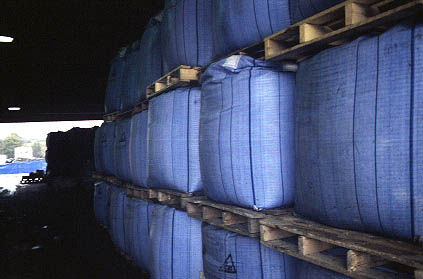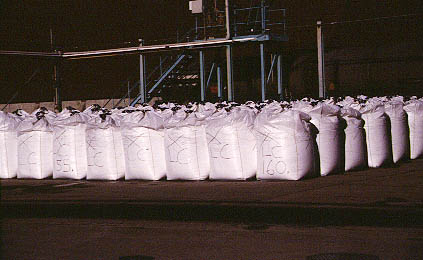|
.jpg)
Filling
FIBC's are normally filled suspended using a lifting device and with the base of the bag on or near the ground or a pallet. If the FIBC has a discharge spout or other discharging device this should be tied off or closed before filling. It is recommended that the manufacturer or supplier should be consulted before filling at temperatures above 60 degrees C.
Stability
FIBC's should be filled so that the ratio of filling height to base is between 0,5 and 2,0 using as base dimensions (i) the diameter of FIBCs with a circular cross section, or (ii) the length of the shorter side for FIBCs with a rectangular cross-section. Other major factors which affect the stability of filled FIBCs are the flow characteristics of the contents, free space and air entrapment. Stability may be often improved by vibration during or after filling to remove entrapped air and cause compaction.
Emptying
FIBCs are usually emptied by gravity but can also be emptied by suction or blowing. The flow characteristics of the contents and the cost of ancillary equipment will generally dictate which method is chosen. When emptying by gravity through a bottom discharge tube, the rate of discharge can be controlled by restricting the width of the aperture. Discharge flow may be stopped completely by lowering the FIBC on to the discharged load. Some single-trip FIBCs are emptied by simply cutting the base of the container. The flow in this case can also be stopped by lowering the FIBC on to the discharged load.
General Safety
To empty single-trip FIBCs the base may be cut using a suitable long handled cutting device. where a discharge spout is provided this should only be released when the FIBC is suspended over a safety support that will prevent injury to the operator in the event of failure of lifting apparatus. Under no circumstances should personnel stand underneath a suspended FIBC or place their arm beneath an unsupported FIBC. Suitable dust control measures should be taken to control any dust that may be generated during filling and emptying operations. The possibility of hazards caused by the build up of static electricity shoulo also be considered and, where necessary, precautions taken. FIBCs should not be used for products other than that for which they were originally intended.
.jpg)
Stacking
When stacking filled FIBCs, every effort should be made to ensure that the stack is stable. where possible the stack should be formed against at least 2 retaning walls, preferably 3, to achieve maxiumum stability; generally the higher the stack the greater the number of retaining walls required. where only free stacking is possible, a pyramid method should be used. FIBCs should not be pushed into a stack as this can led to damage of FIBCs to the side and behind the FIBC being stowed. The practice can also cause slide damage to webbing lifting loops.
Stacking Height
The following aspects should be taken into account when determining the stacking height. This height depends on the pressure developing in the FIBCs stacked at the lower level, the location and the manner in which they are stacked and the stability. If necessary the manufacturer/supplier should be consulted.
Storage
Some filled FIBCs are suitable for outdoor storage, others are not. It is most important that manufacturers' recommendations are followed to obtain the maximum possible life and performance from the FIBC and avoid damage to the contents. It is important that stocks of unfilled FIBCs should be rotated on a regular basis in order to avoid the damage and deterioration which may ensure from long-term storage.
When filled FIBCs are stored in the open (i) particular attention should be paid to the top closure and its method of trying off, (ii) the stack should be sheeted over to prevent water collecting on top of the FIBCs, (iii) if the FIBCs are to be stored in the open for a prolonged period, protection against ultra violet radiation should be provided by covering with black polyethylene or some other sheeting metarial of sufficent thickness to prevent the passage of sunlight, and (iv) care should be taken to ensure that FIBCs are not standing in water and the the area to be used for storage is swept clean of debris that could cause damage to the base of FIBCs at the bottom of the stack.

Lifting FIBCs
Before any FIBCs is lifted it should be checked that it is safe to do so. Personnel should be aware that although FIBCs may have been dispatched in a safe condition, it could be that some units have sustained damage in transit. When a filled FIBC is raised by its top lifting device, the resultant forces may be (i) absorbed by the body and the base of the unit, where the body fabric is extended to form the lifting loops or where other devices are attached to the upper part of the body, or (ii) partially absorbed by separate or integral lifting devices which pass under the body of the container as a form of support. In any case FIBCs should be raised and lowered smoothly avoiding sudden jerks. Cranes and hoists are the most common cause of shock load damage to FIBCs.
Handling with Cranes Hoists
FIBCs should be lifted according to the manufacturer's instructions as shown on the label. The use of safety hooks with integrated latch to avoid accidental slipping of the loop from the hook, particularly when several FIBCs are lifted together, is essential. The correct size and condition of the hook should be checked, in particular (i) hooks should have a sufficiently large radius to avoid squeezing the loop, and (ii) hooks should not have any burns or sharp edges which may cut into the loops.
When the FIBC is suspended the loops must be vertical without any twists or knots. If a suitable spreader is not available a four legged sling should be used. Each leg to measure at least 2 meters. Other lifting methods should only be used if the manufacturer's instructions, as shown on the label, indicate that it is safe to do so. For single point FIBCs one hook is permissible whether hooked directly to the pre-formed loop or to an intermediate collar. In this case particularly, the correct size of the hook must be checked.
FIBCs should not be lifted by putting steel wires, fiber ropes, belt slings or similar materials through one or more lifting loops. Hoisting in that way could produce friction, even frictional heating, and could damage the loops. Several FIBCs may be lifted together if safe and vertical at the loops is provide. Any pendular motion or sideways pulling of the FIBC during lifting should be avoided.
Handling with fork lift trucks
a) Lifting
Care should be taken to ensure that the forks are spaced correctly. FIBCs should be suspended from forks in such a manner that no lateral forces can be created in the FIBC as a result. It should be ensured that lifting loops are not twisted. It is recommended that the projection of fork lift tines beyond the FIBC being handled be kept to a minimum. This will reduce the possibility of accidental damage particularly to other stacked FIBCs. It should be achieved by the use of fork lift tines of the appropriate length and NOT by carrying the FIBC away from the mast of the lift truck.
Puncturing of the main body of the bag either by the forks or by obstacles in the handling area can be avoidedby ensuring personnel are aware of the vulnerability of FIBCs to this type of damage. To avoid severing or damaging the loops, rounded forks, conventional forks that are free of burrs and sharp edges or, if necessary, forks that have been wrapped in a suitable material should be used. When four loops are provided these should always be used and a vertical lift should be applied. where any doubt exists regarding the width of tine to be used (i.e. Greater than 150mm) the FIBC manufacturer olr supplier should be consulted.
Before handling FIBCs mounted on pallets, it should be checked that the pallets are in good condition and that the load is stable. Apart from occasions when pallets are employed, lifting of FIBCs should always be by the lifting arrangements provided; no other method of lifting should be attempted (i.e. using bale clamps, lifting by the filling or emptying spouts, putting slings or strops around the body of the bag, etc.)
b) Horizontal Carrying with FLT's
The truck should be suitable for the load to be carried. When travelling with a FIBC hanging from the forks there is a danger of the truck becoming unstable. The FIBC should be held close to the mast as low as possible with the mast tilted slightly backwards making sure that the FIBC body will not be damaged by the wheels of the truck. The load should not restrict the view of driver.
FIBCs should not be dragged. Trucks should be brought to a standstill before FIBCs are raised or lowered. FIBCs suspended from fork lift tines during transit can be subjected to severe stresses. The occur when excessive speed is used while cornering or driving over uneven surfaces. The following should therefore be avoided (i) harsh acceleration and braking, (ii) excessive speed while cornering, and (iii) excessive speed over uneven surfaces

Transport on trailers and trucks When FIBCs are carried on trucks and trailers. Particular attention should be paid to the stability of the load which should be securely lashed and sheeted. Attention should also be securely lashed and sheeted. Attention should also be given to the load carrying capacity of the vehicle. The FIBCs should be evenly distrubuted, stowed compactly and should not be allowed to project over the side of the trailer.
Storage in freight containers
When FIBCs are packed into freight containers, care should be taken to ensure that the load is evenly distrubuted and properly secured, spaces between FIBCs shoulds be taken up by air bags or other suitable means. Labelling on units nearest to the doors should be visible.
Ship loading
where possible, fork lift trucks should be used to stow FIBCs into the wings of holds. Inducing a swing into the load of a crane and dropping it into place when over the desired position is an uncontrolled operation. A slack crane wire is developed causing a hazard and the body of the FIBC may be damaged against the ships side. In addition the FIBC being stowed, as well as those immediately to the side of or below it, are subjected to unnecessary shock loading. If FIBCs are to be placed temporarily on the dockside to await transport it should be ensured that the area is clear of obstacles such as stones, pieces of wood, scrap metal etc. to avoid damage to the base of the containers. FIBCs should be stowed away from cargoes with sharp edged packing or presenting an abrasive surface. Care should be taken with the use of dunnage in the vicinity of FIBCs.
Fallen FIBCs
To raise an FIBC that has fallen on its side, an endless fabric sling wound through all the loops should be used. Any attempt to lift using fewer loops than those provided may result in loops being torn off.
|